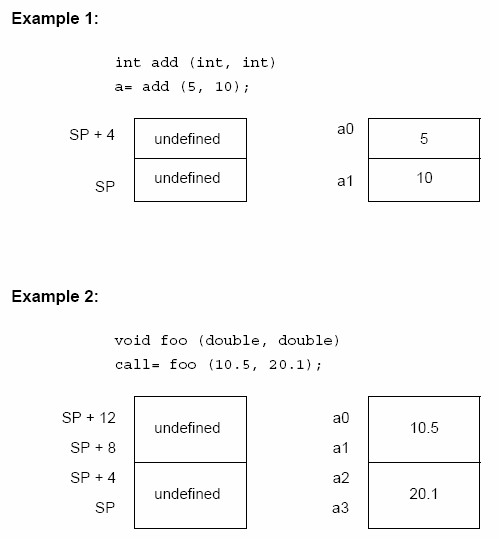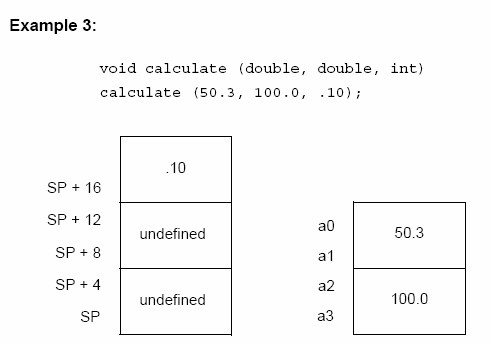Register Conventions
Although most of the registers in the PIC32MX architecture are
designated as General Purpose Registers, there are some recommended
uses of the registers for correct software operation with high-level
languages such as the Microchip C compiler.
Table 1: Register Conventions
CPU
Register
| Symbolic
Register | Usage
|
|---|
| r0 | zero | Always 0 (note 1)
|
| r1 | at | Assembler Temporary
|
| r2 - r3 | v0-v1 | Function Return Values
|
| r4 - r7 | a0-a3 | Function Arguments
|
| r8 - r15 | t0-t7 | Temporary – Caller does not need to preserve contents
|
| r16 - r23 | s0-s7 | Saved Temporary – Caller must preserve contents
|
| r24 - r25 | t8 - t9 | Temporary – Caller does not need to preserve contents
|
| r26 - r27 | k0 - k1 | Kernel temporary – Used for interrupt and exception handling
|
| r28 | gp | Global Pointer – Used for fast-access common data
|
| r29 | sp | Stack Pointer – Software stack
|
| r30 | s8 or fp | Saved Temporary – Caller must preserve
contents OR
Frame Pointer – Pointer to procedure frame on stack
|
| r31 | ra | Return Address (note 1)
|
Note 1: Hardware enforced, not just convention
CPU Special Purpose Registers
The CPU contains three special purpose registers:
- PC – Program Counter register
- HI – Multiply and Divide register higher result
- LO – Multiply and Divide register lower result
- During a multiply operation, the HI and LO registers store the product of integer multiply.
- During a multiply-add or multiply-subtract operation, the HI and LO registers store the
result of the integer multiply-add or multiply-subtract.
- During a division, the HI and LO registers store the quotient (in LO) and remainder (in
HI) of integer divide.
- During a multiply-accumulate, the HI and LO registers store the accumulated result of
the operation.
The MPLAB C32 C compiler dedicates general purpose register 29 as the software
Stack Pointer. All processor stack operations, including function call, interrupts and
exceptions use the software stack. The stack grows downward from high addresses to
low addresses.
By default, the size of the stack is 1024 bytes. The size of the stack may be changed
by specifying the size on the linker command line using the
--defsym_min_stack_size linker command line option. An example of allocating
a stack of 2048 bytes using the command line is:
pic32-gcc foo.c -Wl,--defsym,_min_stack_size=2048
The runtime stack grows downward from higher addresses to lower addresses (see
Figure 1). The compiler uses two working registers to manage the stack:
- Register 29 (sp) – This is the Stack Pointer. It points to the next free location on
the stack.
- Register 30 (fp) – This is the Frame Pointer. It points to the current function’s
frame. Each function, if required, creates a new frame from which automatic and
temporary variables are allocated. Compiler optimization may eliminate Stack
Pointer references via the Frame Pointer to equivalent references via the Stack
Pointer. This optimization allows the Frame Pointer to be used as a general
purpose register.

The C runtime heap is an uninitialized area of data memory that is used for dynamic
memory allocation using the standard C library dynamic memory management
functions, calloc, malloc and realloc. If you do not use any of these functions,
then you do not need to allocate a heap. By default, a heap is not created.
If you do want to use dynamic memory allocation, either directly, by calling one of the
memory allocation functions, or indirectly, by using a standard C library function that
uses one of these functions, then a heap must be created. A heap is created by
specifying its size on the linker command line using the
--defsym_min_heap_size
linker command line option. An example of allocating a heap of 512 bytes using the
command line is:
pic32-gcc foo.c -Wl,--defsym,_min_heap_size=512
The linker allocates the heap immediately before the stack.
The Stack Pointer is always aligned on a 4-byte boundary.


Maintained by John Loomis,
last updated 4 August 2008


